Wondering how to cook brown rice? The first step is to ask yourself: do you want the best, fluffiest brown rice or do you want the quickest, easiest way to get this nutrient-rich grain on your table? I’ve broken down the 2 best ways to cook brown rice with this simple guide, including the pasta method–aka the easiest–and the overnight soak–aka the best texture.
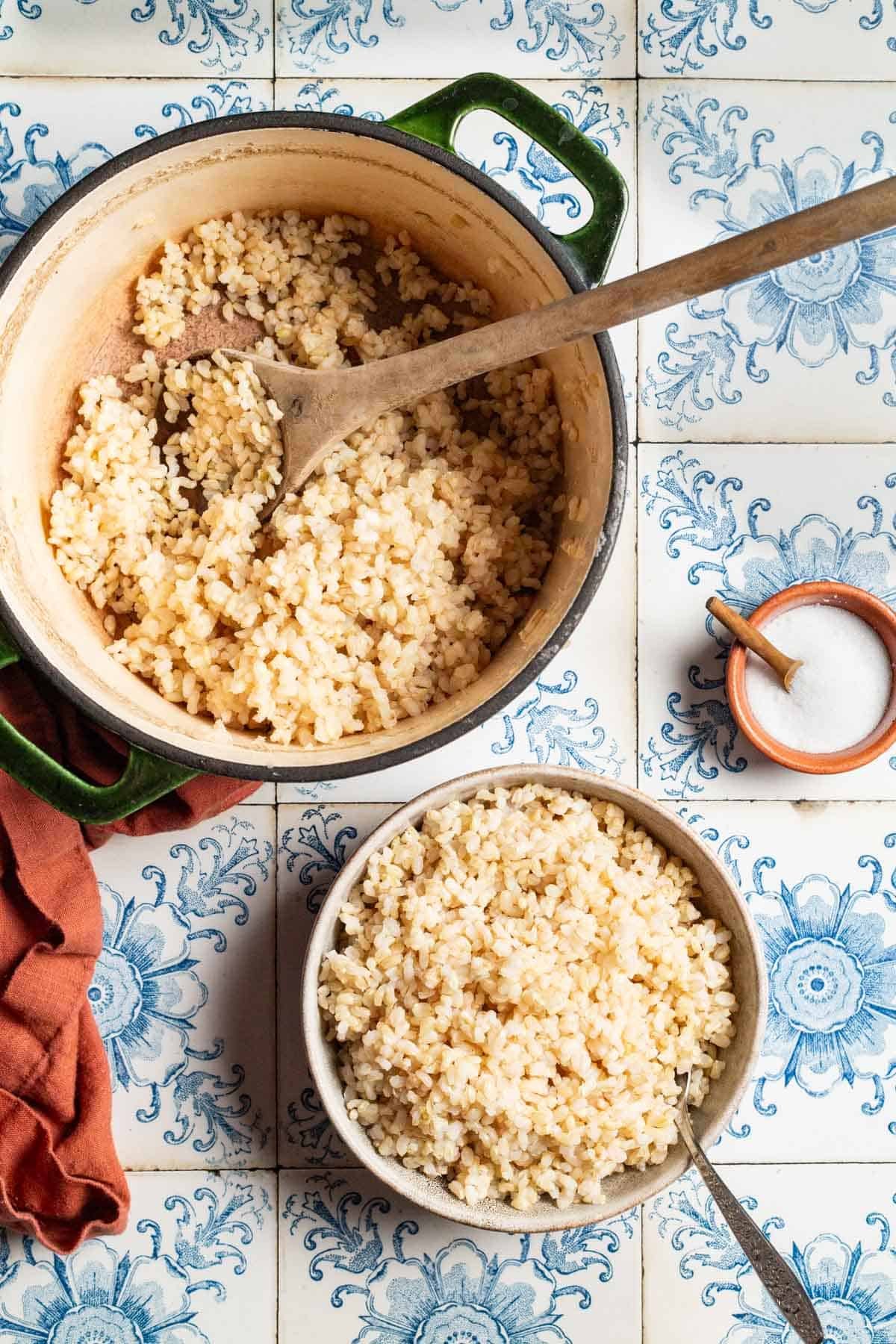
“How to cook brown rice” may not seem like an existential question when you type it into your search bar. That is until you try out every which way to cook brown rice, as I did while testing this recipe. I soaked, I soaked and rinsed, I rinsed without soaking, I boiled, I soaked-to-strained-to-fresh-water–you name it, I tried it.
What I found is you can take one of two paths: you can make the perfect brown rice with the best texture and highest nutritional value. Or you can give yourself a little break and just boil it like pasta.
If I had to pick just one method, I would say the overnight soak is the way to go—I suppose I’m a perfectionist at heart. You need to plan ahead but there’s no need to rinse. You can put it on the stove straight from your fridge and it cooks in 30 minutes. As a bonus, the rice begins to germinate, making it easier for you to digest and absorb its nutrients.
On the other side of the coin, the ease of not even grabbing a measuring cup appeals to me on a deep level. So when you didn’t plan ahead and have 30 minutes to get dinner on your table, grab whatever mug is closest to you and scoop the rice right into boiling water just like you’re making pasta.
Make a simple tomato salad, poach salmon in white wine, and pour yourself a glass while you’re at it. Sometimes dinner can just be simple and stress-free and that’s perfect in its own way too.
Table of Contents
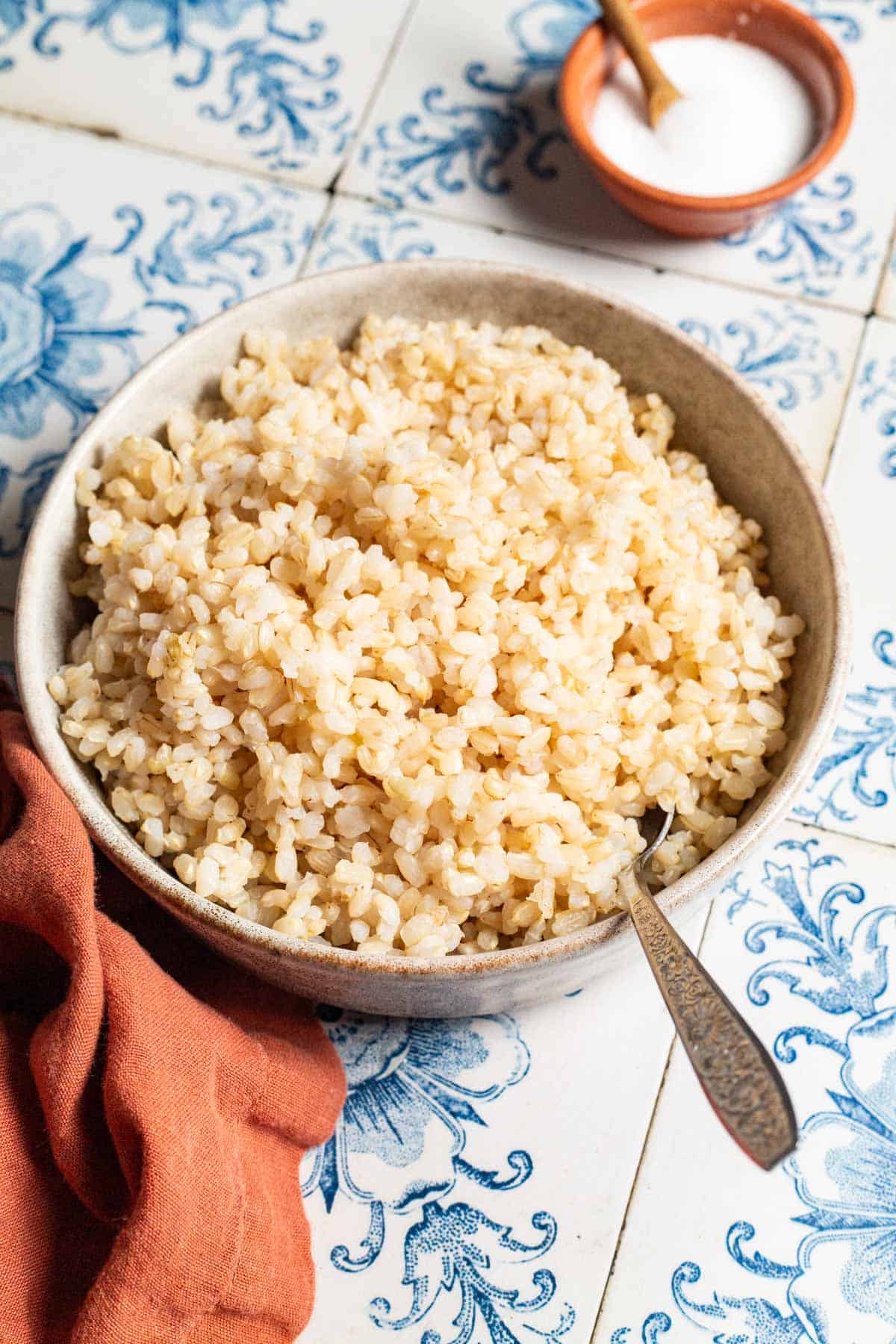
What is Brown Rice?
Brown rice is a less processed version of white rice. Both kinds come from the same plant but brown rice has its germ and bran left intact. Brown rice contains both soluble and insoluble fibers which can help with digestion, and has a lower glycemic index than white rice.
Rice itself is a cereal grain made from the seed of a grass species called oryza sativa. The plant looks very similar to wheat, with a tall, sturdy stalk and a cluster of rice grains at the top that droop like the branches of a willow tree.
The seeds are harvested, dried, and “threshed,” which separates the grains from the stalks and husks. The seed is then hulled, which removes the outer protective layer from the grain—aka brown rice. To make white rice, the grain is then “polished” which removes the bran and germ.
- READ MORE: Is Brown Rice Healthy?
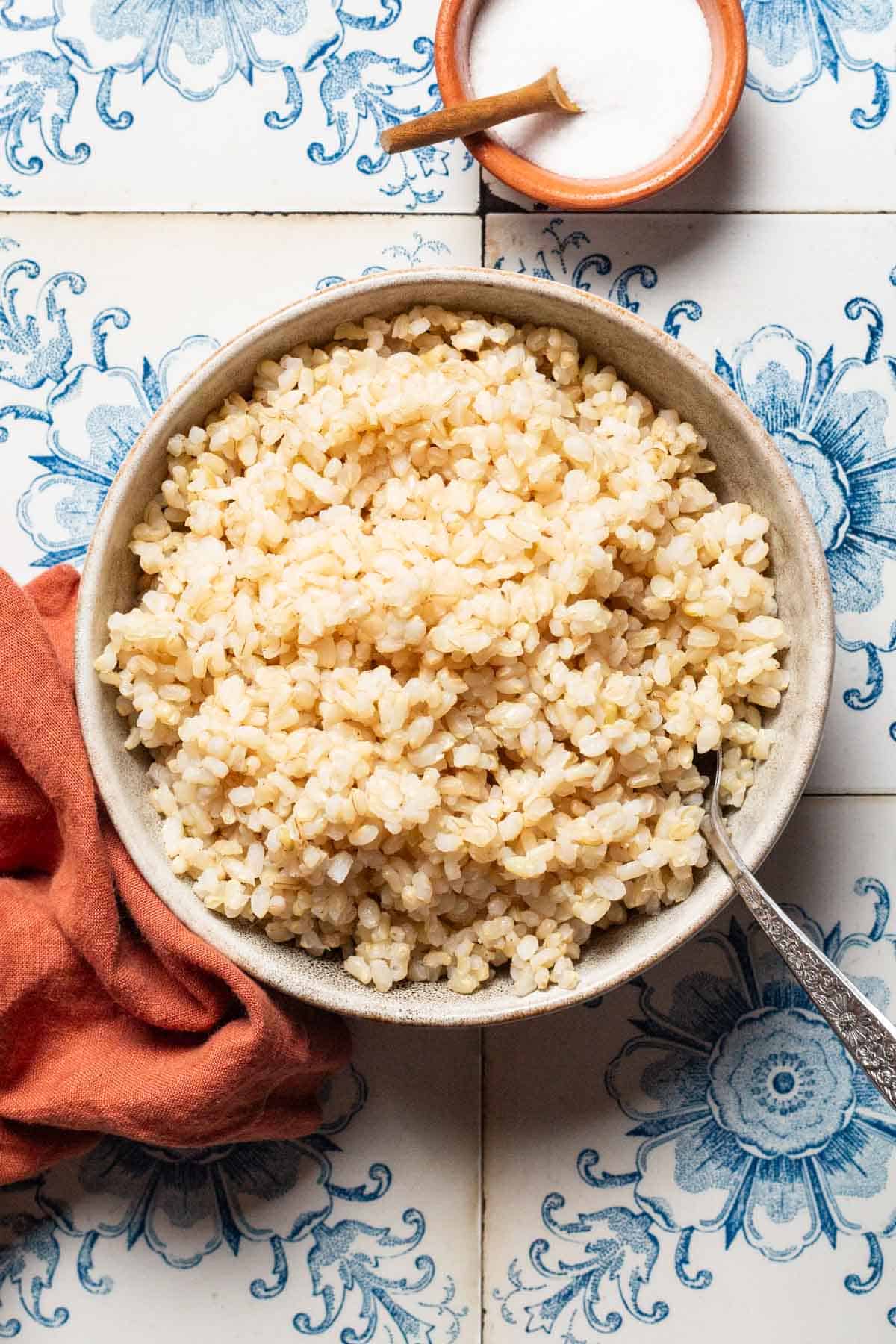
To Rinse or Not to Rinse?
There are two reasons to rinse rice: First to remove starch from the grains, which in theory makes it fluffier. Second is to remove debris, since rice is an agricultural product that tends to sit on store shelves.
I’m a big rinse person when it comes to cooking white rice in the traditional method, like the basmati rice that’s most often used in Mediterranean, North African, and Middle Eastern recipes. I rinse until the water runs clear–unless I’m stirring arborio rice for risotto. In that case, stirring the rice with the starch gives it that perfectly velvety texture, weather it’s mushroom risotto or butternut squash risotto.
So why didn’t I rinse the rice for this brown rice recipe? I tested rinsing the rice before cooking from the package instructions, and the grains were indeed more separated and fluffier. But with the overnight soak and quick-boil methods, I found no difference in the texture of the rice when it was rinsed versus when it was not rinsed.
Since I found that soaking the rice overnight was the best texture and didn’t require rinsing, I don’t see the need to dirty another dish. But if you’d prefer to rinse for good measure, by all means feel free!
How to Cook Brown Rice
Option 1: Soak then Simmer (Best Texture)
- About 10-12 hours before cooking the rice, soak. In a large saucepan, add the rice, 2 cups of cold water, and a pinch of salt (about 1/4 teaspoon). Give it a good stir, cover, and set in your fridge to soak.
- Cook the rice. Remove the pan from the fridge, uncover, and set it right on your stove. Bring to a boil over high heat. When the whole pot is boiling–including the center–turn the heat to medium-low, cover, and simmer for 20 minutes without lifting the lid or stirring.
- Let sit. Remove the rice from the heat. Lift the lid and immediately cover the rice with a clean kitchen towel, then replace the lid. Leave for 10 minutes without peeking–the towel will absorb the excess steam.
- Fluff. Use a fork to fluff the rice, separating the grains.
Option 2: Cook like Pasta (Easiest/Fastest)
- Get ready. Bring a large saucepan filled with water to a boil over high heat. Once boiling, season with a big pinch of salt.
- Boil until tender. Add the rice and give it a stir. Boil until the rice is tender but not mushy, about 30 minutes.
- Drain. Drain through a fine mesh strainer. Enjoy immediately, or allow to cool completely and store in an airtight container in your fridge for a couple of days.
What are “Whole Grains”?
Whole grains keep all three parts of the kernel: the bran, germ, and endosperm. Removing these parts of the kernel makes cakes and white bread extra fluffy, but it also removes a lot of its nutritional value.
Whole grains are considered healthier because the grain remains intact, which results in higher nutrients, fiber, and other beneficial compounds.
Examples of whole grains include brown rice, whole wheat, quinoa, barley, freekeh, rye, bulgur, amaranth, and buckwheat.

How to Long to Cook Brown Rice
How long to cook brown rice depends on how you cook it. If you’re using the traditional method that’s typically on the package, you’re looking at around 45 minutes. Soaking it overnight cuts back the time to about 30 minutes. The same goes for a more vigorous boil–the “pasta method”–which takes about 30 minutes.
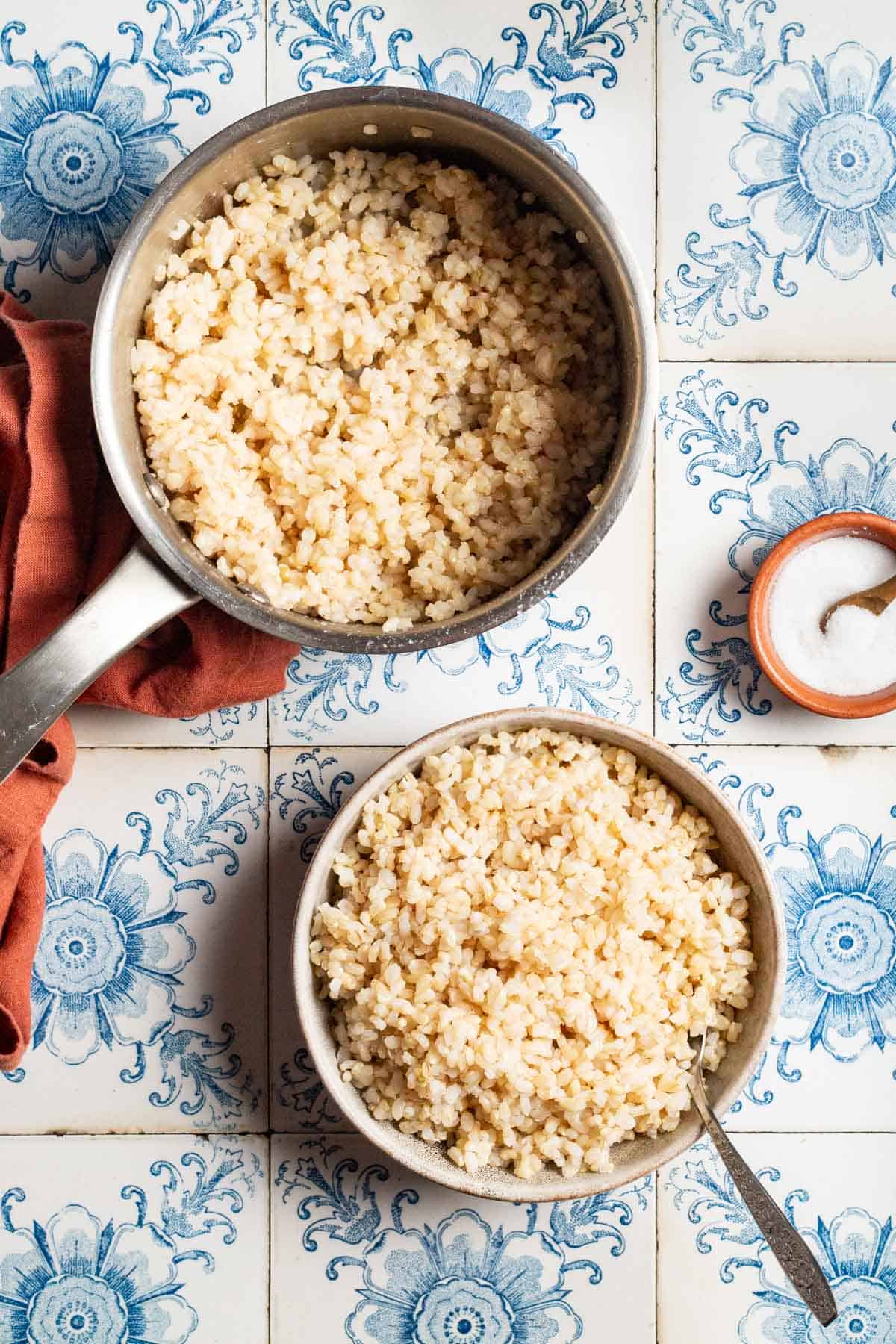
How Much Rice Per Person?
The standard is 1/2 cup to 1 cup of cooked rice per person. Rice expands as it cooks, so 1 cup of uncooked rice will feed up to 6 people with 1/2 cup servings or 3 people with 1 cup servings.
What’s the Best Water to Rice Ratio for Brown Rice?
This varies depending on your cooking method, but generally, two parts of water to every 1 part rice works well for brown rice. If you’re doing the pasta method, there’s no need to measure the water (or rice for that matter). Just make sure to submerge the rice in water.
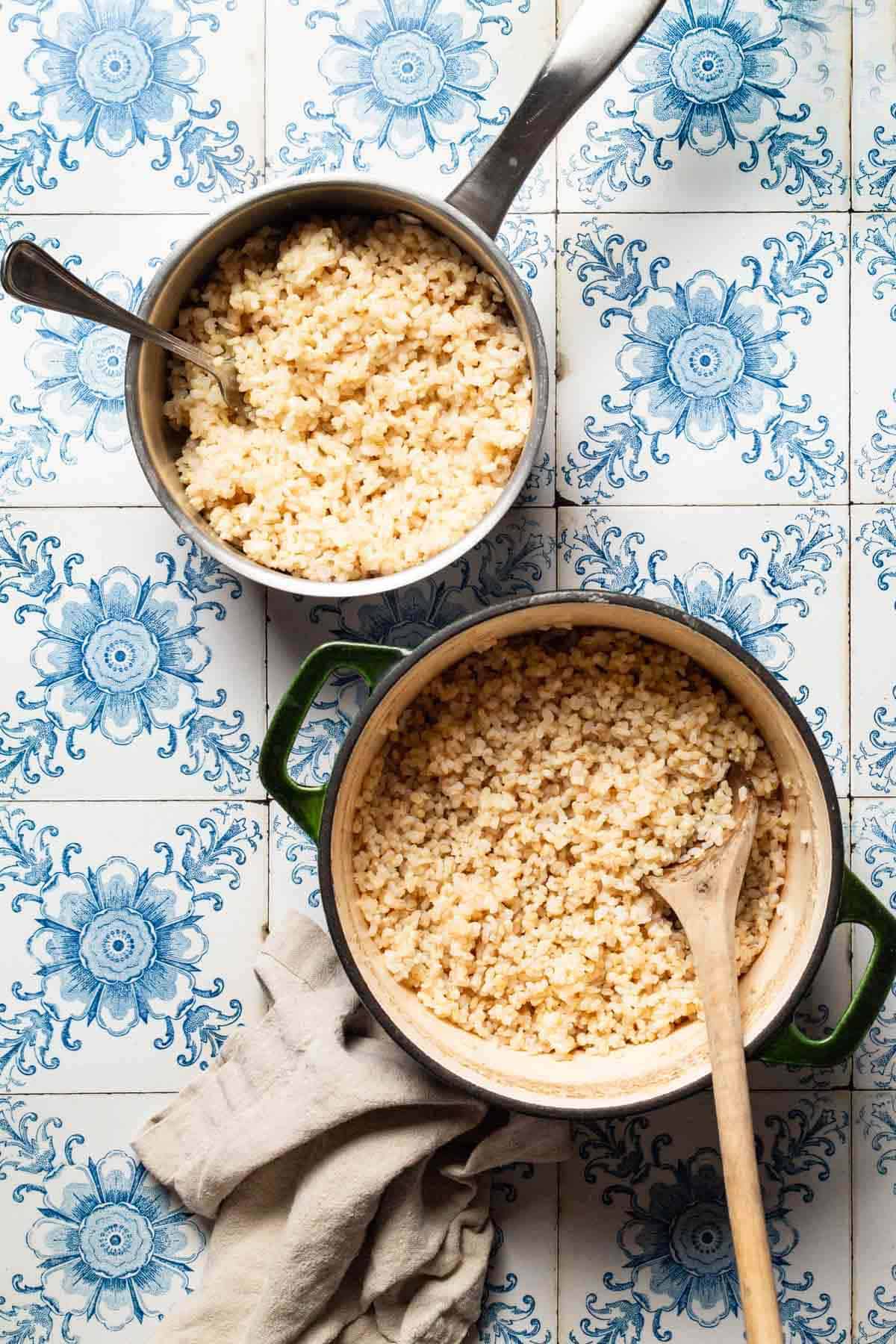
What to Serve with Brown Rice
Whole grains are a beginner step in beginning to eat the Mediterranean way! So it’s not a bad idea to keep a rotating pan of brown rice soaking in your fridge to serve along with more healthy weeknight dinners. Some favorites:
- Chicken: Easy Cilantro Lime Chicken, 20-Minute Mushroom Chicken, or Grilled Chicken Kabobs.
- Beef: Mediterranean-Style Beef Bowls.
- Fish: One-Pan Baked Halibut with Vegetables, Mediterranean-Style Garlic Shrimp Recipe With Bell Peppers, Sheet Pan Salmon with Vegetables, Moroccan Fish.
- Pork: Chorizo, Tomato, and Charred Corn Salad
- Vegan: Easy Greek-Style Eggplant, Moroccan Vegetable Tagine, or Grilled Vegetable Kabobs.
Up Your Grain Game!
Browse all Mediterranean recipes.
Visit Our Shop.
Freekeh, Farro, Barley, and More!
Stock your pantry with the Mediterranean’s best products.
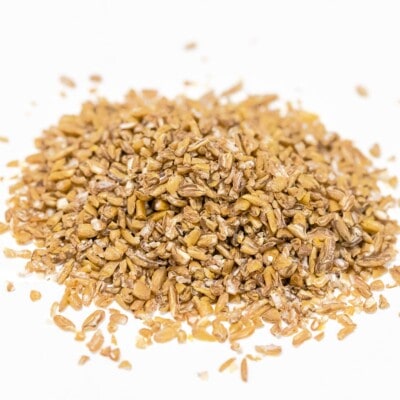
How to Cook Brown rice
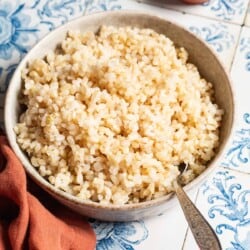
Ingredients
- 1 cup brown rice
- Kosher salt
Instructions
Option 1: Soak then Simmer (Best Texture)
- About 10-12 hours before cooking the rice: soak. In a large saucepan, add the rice, 2 cups of cold water, and a pinch of salt (about 1/4 teaspoon). Give it a good stir, cover, and set in your fridge to soak.
- Cook the rice. Remove the pan from the fridge, uncover, and set it right on your stove. Bring to a boil over high heat. When the whole pot is boiling–including the center–turn the heat to medium-low, cover, and simmer for 20 minutes without lifting the lid or stirring.
- Let sit. Remove the rice from the heat. Lift the lid and immediately cover the rice with a clean kitchen towel, then replace the lid. Leave for 10 minutes without peeking–the towel will absorb the excess steam.
- Fluff. Use a fork to fluff the rice, separating the grains.
Option 2: Cook like Pasta (Easiest/Fastest)
- Get ready. Bring a large saucepan filled with water to a boil over high heat. Once boiling, season with a big pinch of salt.
- Boil until tender. Add the rice and give it a stir. Boil until the rice is cooked to your liking, about 30 minutes.
- Drain. Drain through a fine mesh strainer. Enjoy immediately, or allow to cool completely and store in an airtight container in your fridge for a couple of days.
Notes
- A note on rinsing: Rinsing rice removes the starch and any debris from the grain, making the rice fluffier and less mushy. And I’ll just say I’m a big rinse person when it comes to cooking white rice. I would also rinse brown rice if the traditional way from the package. But I tested these two methods both with rinsing the rice and without rinsing the rice and found no difference. The soaking and boiling seems to take care of that for you, and it wasn’t worth another dish and 5 minutes time. But if you’d prefer to rinse for good measure, by all means feel free!
- 1 cup of uncooked rice will yield about 3 cups of cooked rice. If you’d like more, keep the 1:2 rice to water ratio. That means for 2 cups of uncooked rice (which will yield 6 cups of cooked rice), soak in 4 cups of water.
- Visit our shop to browse quality Mediterranean ingredients including olive oils, honey, jams, and spices.
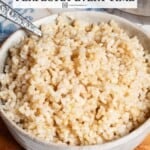
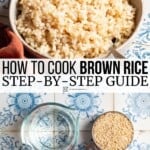
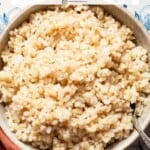
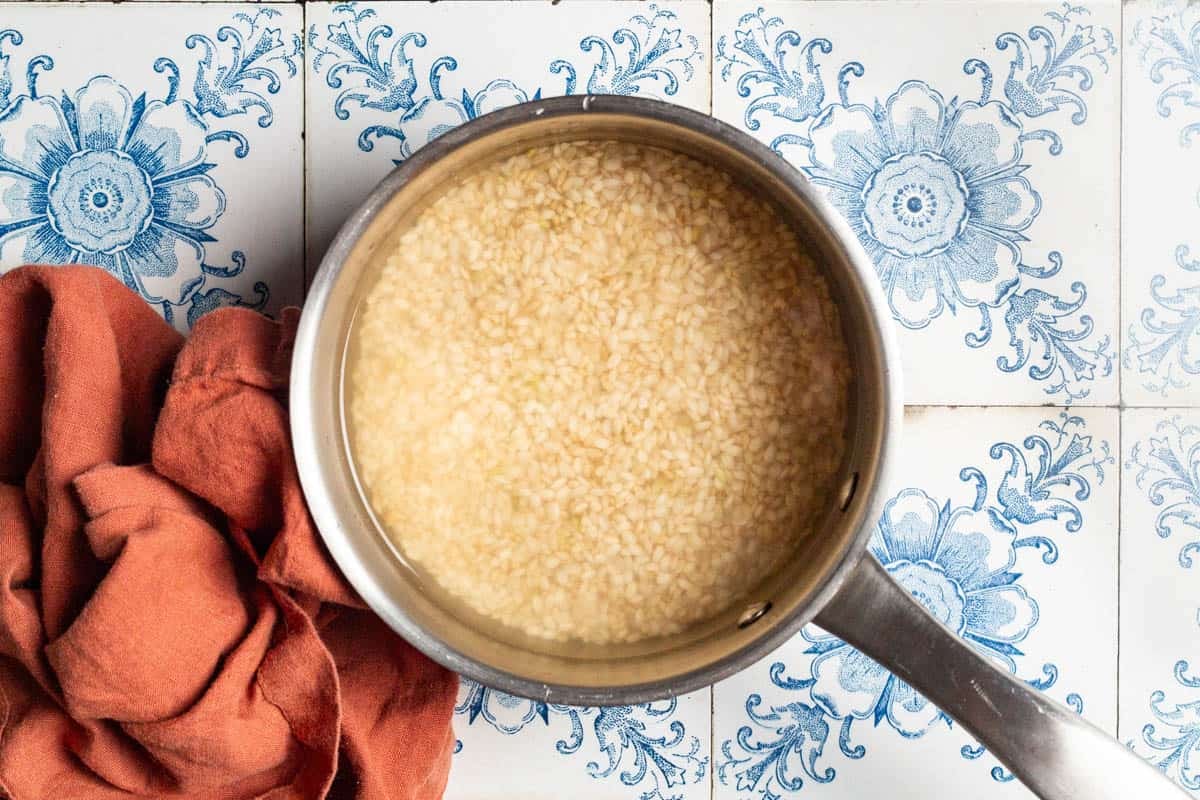
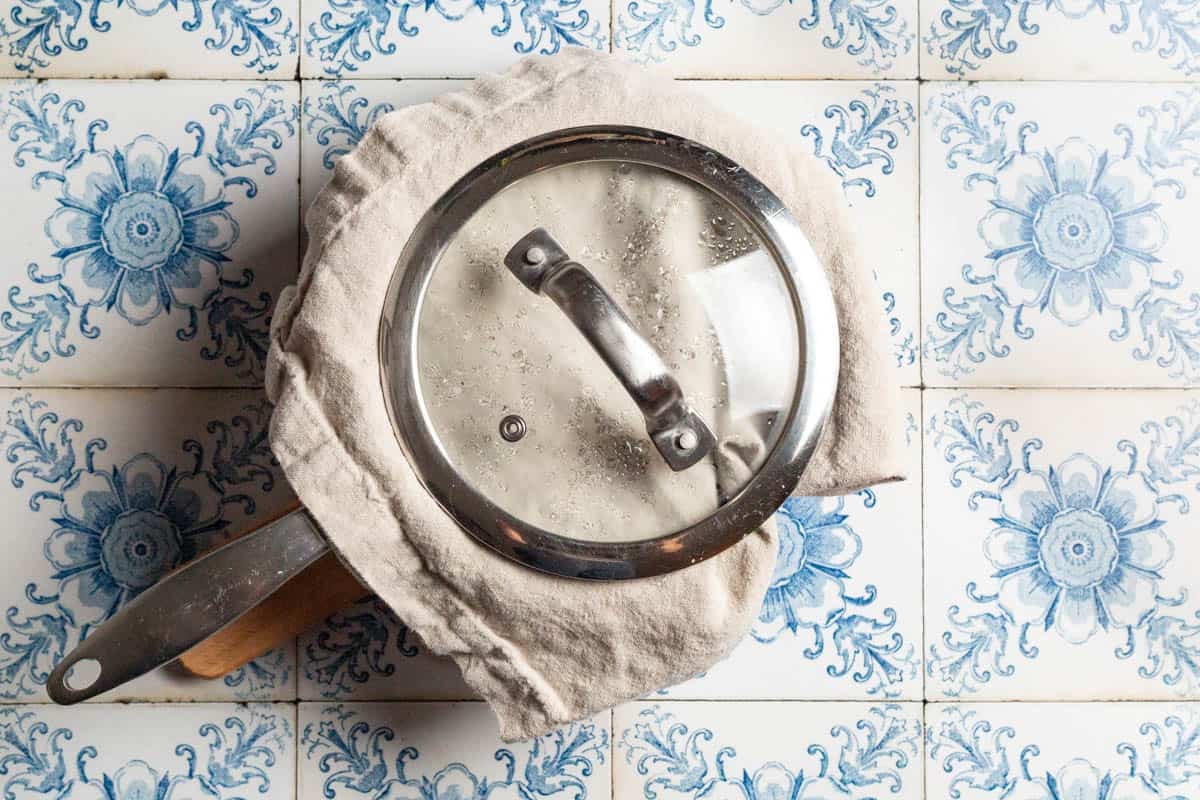
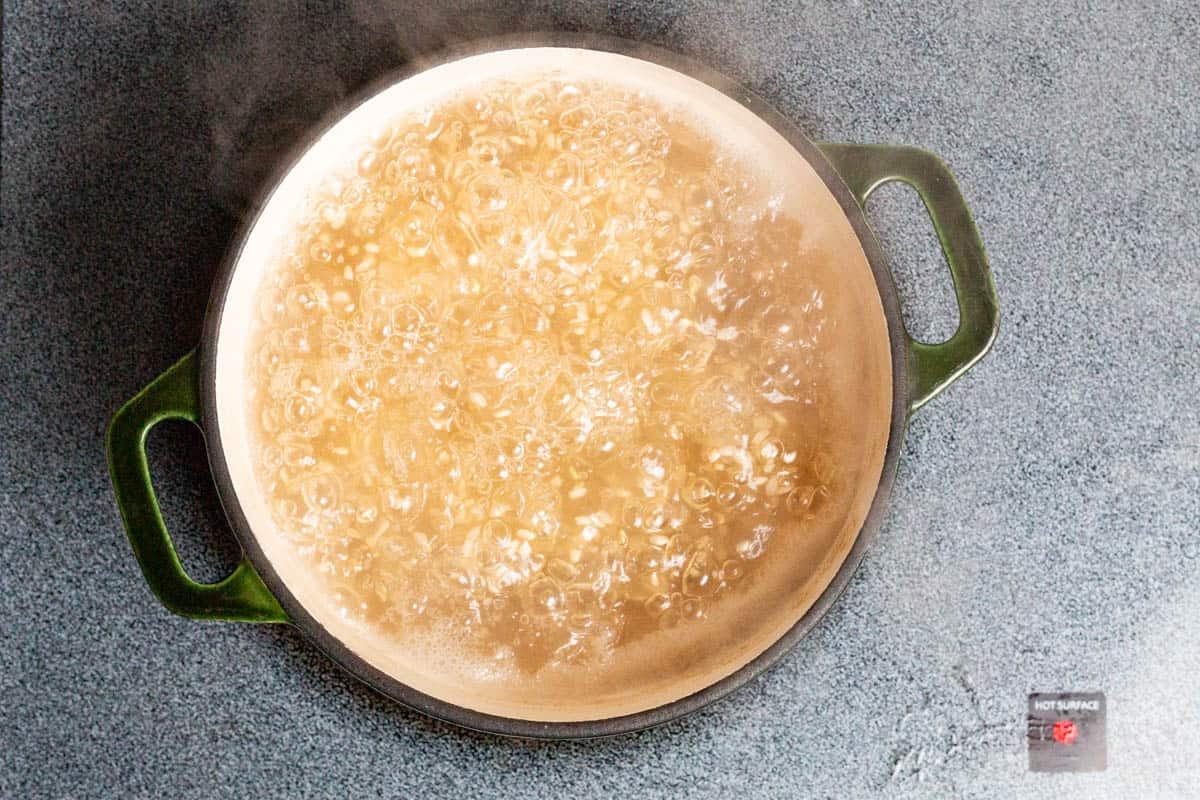
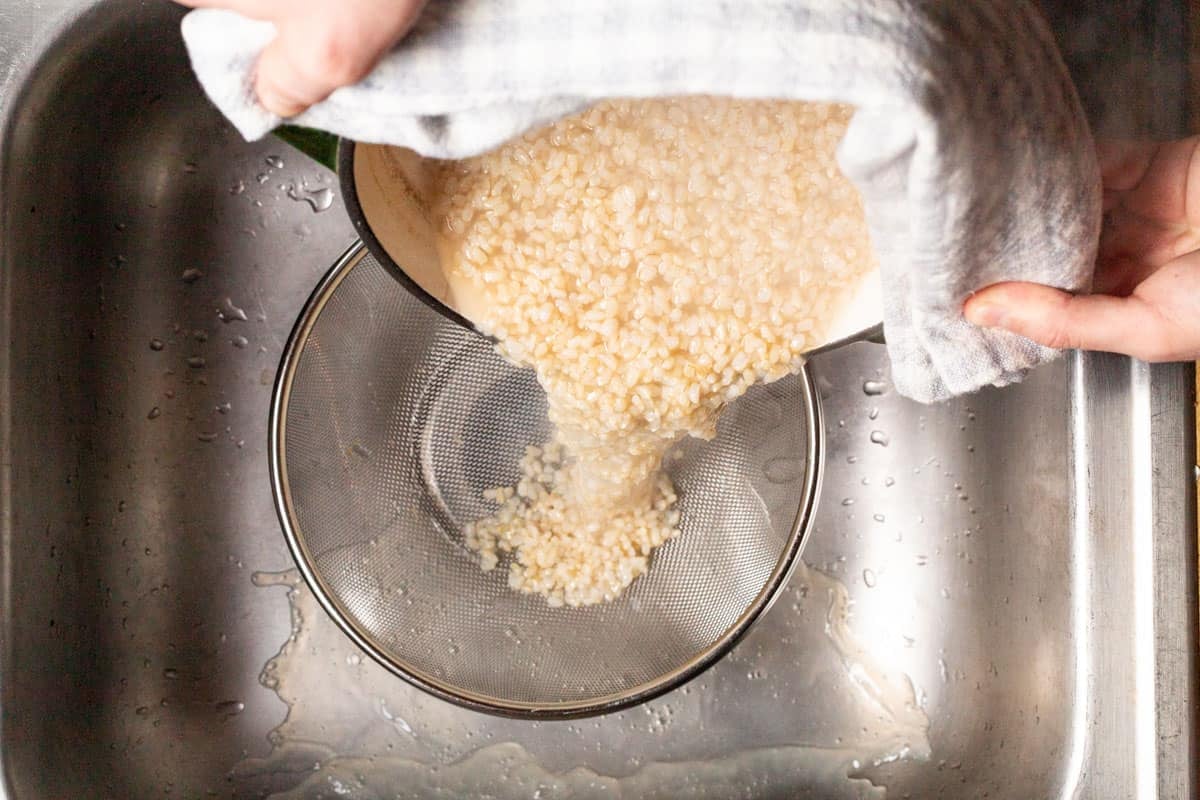
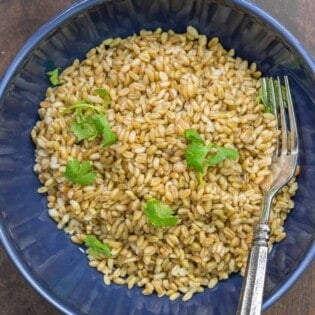
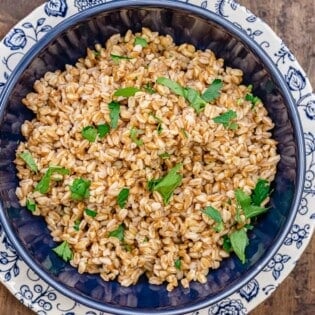
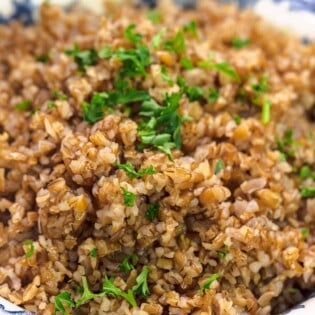
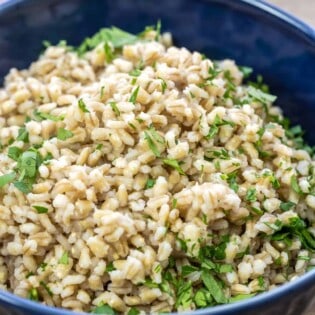
What’s the purpose of soaking in the refrigerator? Is it simply a precaution for food safety? Typical refrigerator temperatures actually prevent the germination process from starting. Did you happen to test soaking on the countertop? I’m wondering if that would require less time.
Question. Does this work for both long grain and short grain brown rice? Right now, I have the long grain.
I accidentally drained the water after soaking it all night, oops! Should I still use 2:1 ratio?
turns out you can make brown rice wrong and boy had i been making it wrong. constantly not awesome so i went searching (while feeling silly for doing so) for how to properly make it where it’s not either undercooked or overcooked and Suzy + team came through (as always!). the soaking overnight method is the only way i’ll ever make it again!
Yay! We’re so glad we could help you figure this out :).
Hi, I bought some of your spices and I’d like to know if you ever add a particular spice to the rice while it’s cooking and how much do you add? Thanks!
Hi, Debbie! Using spices or combinations of spices such as Cumin, Paprika, Aleppo pepper, Red pepper flakes, Garlic powder, Onion powder, Salt, Pepper and many more is a great way to give plain rice and extra burst of flavor. We don’t really have a recipe using these spices, so you may just have to experiment a bit to find the right amount to suit your own taste. Thanks so much for reaching out!